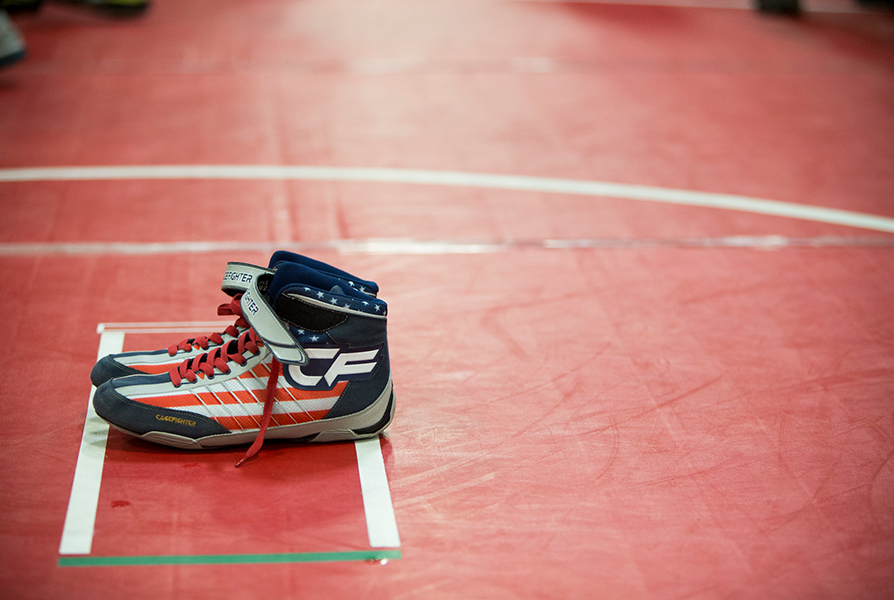 Associate and Engineering Project Manager Chris Giles approaches his work much like a wrestler approaches the sport—with deliberation and discipline. “If the ultimate goal in sports is to be undefeated and without flaw, I strive to push our department to always reach for a higher level of efficiency, thorough design and flexibility,” says Chris.
Associate and Engineering Project Manager Chris Giles approaches his work much like a wrestler approaches the sport—with deliberation and discipline. “If the ultimate goal in sports is to be undefeated and without flaw, I strive to push our department to always reach for a higher level of efficiency, thorough design and flexibility,” says Chris.
In nearly 16 years at Baskervill, Chris’ desk has become a shrine of sorts, littered with family photos, motivational messages and stacks and stacks of project drawings he’s worked on. Others within the department have jokingly dubbed a nearby drafting table as Chris’ annex, because he has a way of taking over the space for meetings and project check-ins.
How did you grow into your electrical engineering role?
I started at the University of Maryland and then transferred to East Carolina University (it’s worth noting he wrestled competitively at both schools). In the early 1980s, jobs were few and far between. My father, who’s a retired structural engineer, helped get me interviews at different firms. I started as a mechanical designer and then moved over to electrical design.
I’ve always enjoyed art and the artistic side of things; as I started drafting and learning the trade and design, I realized how much I enjoyed putting drawings together. It helped to have a common art background to visualize the data and set up the sheets. Gosh, that was about 40 years ago now.
It’s impossible to talk about Chris Giles without covering wrestling. And, I hear you’ve recently designed a wrestling facility. What was that like?
When I was 12, my brother became a part of Henrico High School’s first wrestling team. No one really knew what wrestling was about back then, and I was hooked. I wrestled in high school and college, coached for a while—today, I actively officiate matches.
actively officiate matches.
(To brag on Chris, he’s been involved in wrestling for 45 years and was inducted into the Virginia Chapter of the National Wrestling Hall of Fame in 2016 for his lifetime service to the sport.)
So, yes, this project for a college in Virginia meant a lot to me. The wrestling team called the facility “Thunderdome,” because the space was so dark and dingy. I actually reffed in this space at one time, and you’d see team members head to the upper-level track space and bang their class rings on the railings to amp up the intimidation factor.
A key component we designed for the new facility was an ambient lighting system with wireless controls. You see, when you’re down on the mat, trying to outmaneuver your opponent, shadows are everything. They give insight into the opportunities, placement and movement of the opponent. The system allows people to control each light individually or as a group, and for team introductions there are some nice theatrical lighting options. It’s not WWE, but still pretty cool. It’s my dream to officiate in the new space sometime soon.
Tell me more about what your day-to-day looks like at Baskervill.
Well, I started out as an electrical designer at Baskervill, and about three years ago I became an engineering project manager. I’m responsible for building fees, working on proposals and making sure all the pieces are in place for teams to excel and get work out the door within a desired budget. I also run quality assurance on drawing sets before they go out. No day’s the same; I can be working on an aquatics facility and then shift gears to three new-build hotels the next.
Beyond that, I work very closely with our clients. People often forget about what I call the “back of house” mechanical, electrical and plumbing (MEP) systems, but they’re the backbone of any space. The lights need to function and the toilets have to work, and there’s no room for error.
A generator or air handling unit might not seem like something to get excited by, and that’s why it takes an extra level of effort to show clients how these systems are a critical part of the project that are deeply integrated with any facility’s goals. I want people to always feel comfortable and confident in our abilities, so they ask questions that lead to a better understanding of how to control, monitor and maintain all these critical elements.
What’s your favorite part of your job?
There’s something special about when engineers, architects and interior designers can all work together under one roof. It takes coming at a design from many different perspectives to land on the best solution. My favorite part about the job is the people. We lean on and learn from each other—which allows people across the firm to understand what we engineers look for and consider when thinking through MEP systems, evaluate spaces and cohesively meet client needs.


